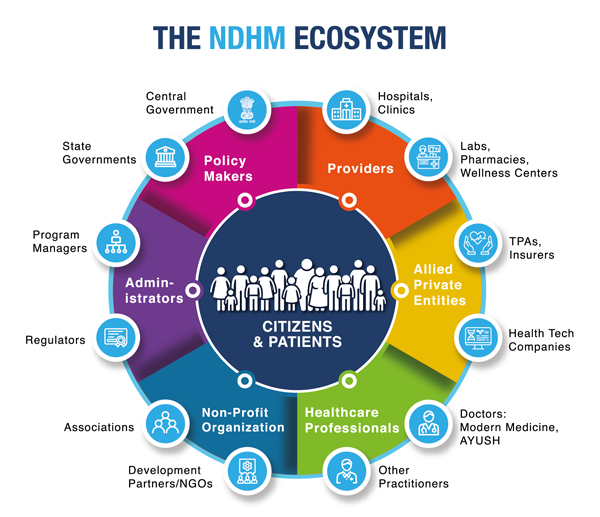Governance
Ayushman Bharat Digital Mission
- 28 Sep 2021
- 5 min read
Why in News
Recently, the Ayushman Bharat Digital Mission was launched by the Prime Minister through a video conference.
- The nationwide rollout of the project coincides with the National Health Authority (NHA) celebrating the third anniversary of Ayushman Bharat Pradhan Mantri Jan Arogya Yojana (AB PM-JAY).
- Ayushman Bharat is a flagship scheme of India which was launched as recommended by the National Health Policy 2017, to achieve the vision of Universal Health Coverage (UHC).
Key Points
- About:
- It aims to provide digital health IDs for all Indian citizens to help hospitals, insurance firms, and citizens access health records electronically when required.
- The pilot project of the Mission had been announced by the Prime Minister from the ramparts of the Red Fort on 15th August 2020.
- The project is being implemented in the pilot phase in six States & Union Territories.
- Features of the Mission:
- Health ID:
- It will be issued for every citizen that will also work as their health account. This health account will contain details of every test, every disease, the doctors visited, the medicines taken and the diagnosis.
- Health ID is free of cost, voluntary. It will help in doing analysis of health data and lead to better planning, budgeting and implementation for health programs.
- Healthcare Facilities & Professionals’ Registry:
- The other major component of the programme is creating a Healthcare Professionals’ Registry (HPR) and Healthcare Facilities Registry (HFR), allowing easy electronic access to medical professionals and health infrastructure.
- The HPR will be a comprehensive repository of all healthcare professionals involved in delivering healthcare services across both modern and traditional systems of medicine.
- The HFR database will have records of all the country’s health facilities.
- Ayushman Bharat Digital Mission Sandbox:
- The Sandbox, created as a part of the mission, will act as a framework for technology and product testing that will help organisations, including private players intending to be a part of the national digital health ecosystem become a Health Information Provider or Health Information User or efficiently link with building blocks of Ayushman Bharat Digital Mission.
- Health ID:
- Implementing Agency:
- National Health Authority (NHA) under the Ministry of Health and Family Welfare.
- Expected Benefits:
- Ensure ease of doing business for doctors and hospitals and healthcare service providers.
- Enable access and exchange of longitudinal health records of citizens with their consent.
- Create integration within the digital health ecosystem, similar to the role played by the Unified Payments Interface (UPI) in revolutionising payments.
- Concerns:
- The lack of a data protection bill could lead to the misuse of data by private firms and bad actors.
- Exclusion of citizens and denied healthcare due to faults in the system are also a cause of concern.
Way Forward
- The NDHM still does not recognize Health as a justiciable right. There should be a push draft at making health a right, as prescribed in the draft National Health Policy, 2015.
- In addition, the failure of a similar National Health Service (NHS) in the United Kingdom must be learnt from and the technical and implementation-related deficiencies must be proactively addressed prior to launching the mission on a pan India scale.
- The standardisation of NDHM architecture across the country will need to find ways to accommodate state-specific rules. It also needs to be in sync with government schemes like Ayushman Bharat Yojana and other IT-enabled schemes like Reproductive Child Health Care and NIKSHAY etc.





